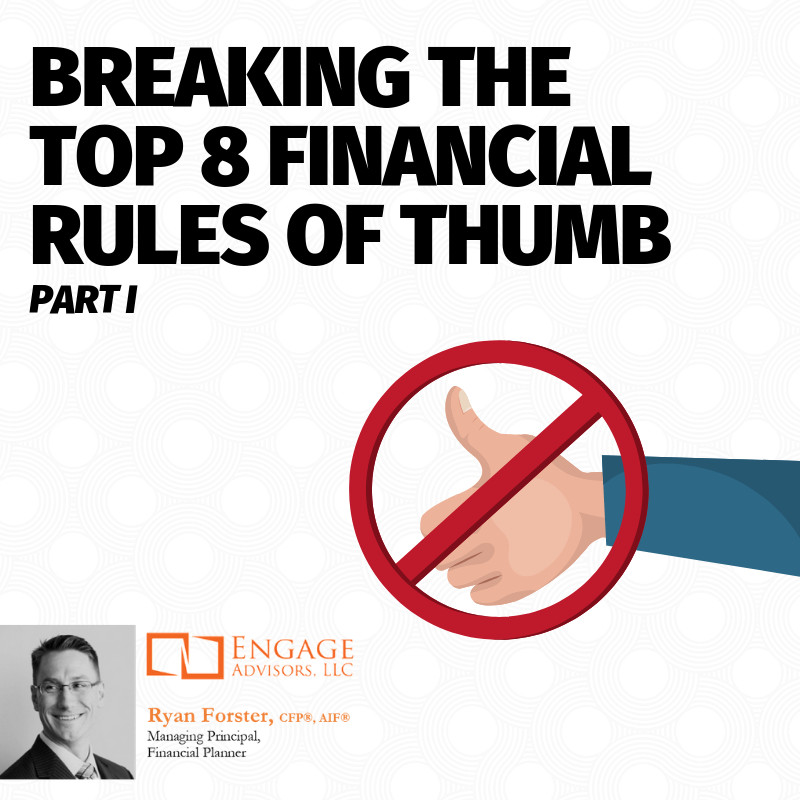Rule of Thumb: a principle with broad application that is not intended to be strictly accurate or reliable for every situation.
Many terms evolve from history and the origin of the “rule of thumb” is popularly attributed to the width of a switch to legally “discipline” your spouse circa 1800 AD. In actual literature, the term was used as a common unit of measurement.
Most can appreciate a good rule of thumb because it may give some guidance for a specific need. What most don’t consider is that a rule of thumb is broad guidance meant to add general direction within a set of data. There is no actual specificity. In the financial industry, we call this blanket advice. There’s a reason I’m prohibited from giving blanket advice by industry regulators. Advice can be misconstrued as bad advice if it doesn’t pertain to someone’s specific situation… Here’s a list of a few financial “rules of thumb”.
- A house should cost less than 2.5 x your income
- Save at least 10% of your take-home income for retirement
- Have at least 5x your income in life insurance
- Pay off high-interest credit cards first
- The stock market returns 10% per year
- You should have an emergency fund of at least 3-6 months of household expenses
- You should only pull 4% of your assets as retirement income.
- Your age should represent the % of bonds in your portfolio
Every financial household will be full of exceptions to the “rules” above, based on unlimited variables. Don’t be surprised if only one or two of these actually work for you.
Over the next few weeks, we will dive deeper, for now, let’s explore the surface of 3 favorites.
- Have at least 5x your income in life insurance. This assumes everyone has an insurable need, which many of us don’t. And what if there’s only one income in the family? At $200k annual income and the earner passes away. This “rule” calls for $1 million to protect the family. Using rules above, $1 million in life insurance leaves about $40,000 annual replacement income. This won’t come close to covering prior living expenses, won’t help the kids through college, let alone retirement for the surviving, unemployed spouse.
- Save at least 10% of your take-home income for retirement. This ignores time, savings, increasing income, pension, social security, taxable investing and more. I will illustrate in a later blog but to avoid confusion: Higher income earners must save more than lower income earners simply because of social entitlements. Saving 10% might work for someone who starts early, but most people don’t. The shorter the time to save, the greater the % saved needs to be and it almost always turns out to be greater than 10%.
- The stock market returns 10% per year. Try not to laugh after the last year’s horrible performance. This rule is exceedingly fun because the assumption is that it will return 10% while you are invested, especially when you need it and that you can invest directly in an index without expenses. All are almost always false. And which market? For the S&P 500 index, the number changes constantly. When I started financial planning in 2007, 12% was the “rule of thumb”, in the 90s surveys claimed 20%+, now I hear anywhere from 8-10%(notice a trend?). If we take all years in the S&P 500’s history, we’re around 9.5%. Some decades are a boom (1990s returned 18%/year), some decades are bust (2000s returned 1%/year). No rule of thumb works for stock market returns.
Moral of the story, a rule of thumb will give us guidance to know if we’re moving in the right direction. The only rule of thumb I recommend is you should seek sound advice from an experienced professional such as your friendly team at Engage Advisors, LLC. Consultation is free and our coffee is good.
For more information, please call Ryan at (913)681-9155 or email ryan@engageadvisors.com
Engage Advisors, LLC is a Registered Investment Adviser. This platform is solely for informational purposes. Advisory services are only offered to clients or prospective clients where Engage Advisors, LLC and its representatives are properly licensed or exempt from licensure. Past performance is no guarantee of future returns. Investing involves risk and possible loss of principal capital. No advice may be rendered by Engage Advisors, LLC unless a client service agreement is in place.

